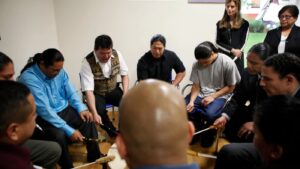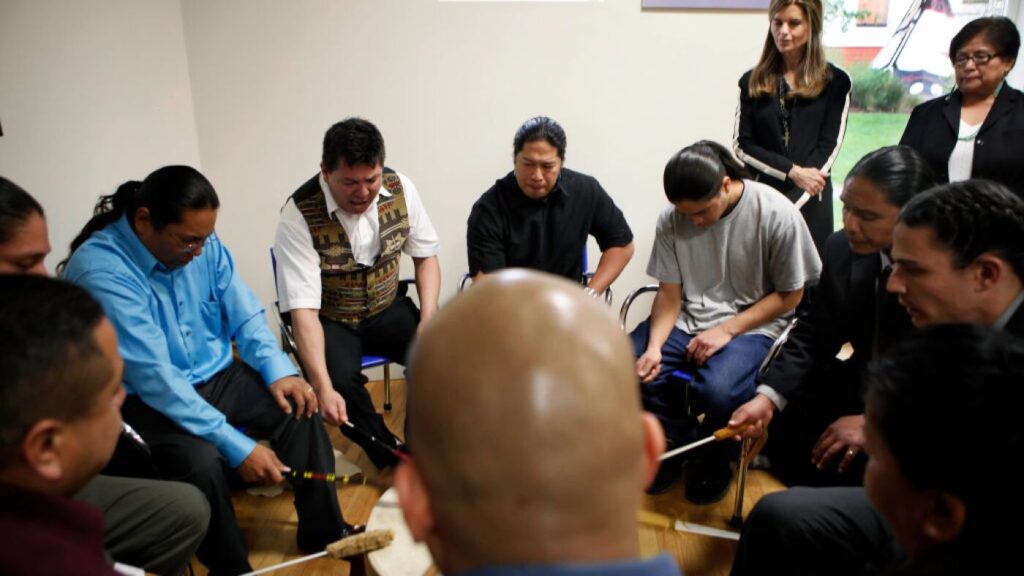A drumming circle on the Friendship Home in San Francisco. Friendship Home is a Native-led restoration remedy program that gives culturally related care.
San Francisco Chronicle/Hearst Newspapers/Getty Photographs
cover caption
toggle caption
San Francisco Chronicle/Hearst Newspapers/Getty Photographs
Emery Tahy of San Francisco is aware of firsthand the struggles of dependancy and restoration — a journey that, for him, is intertwined together with his expertise as a Native American.
In his twenties, Tahy landed on the streets of Phoenix battling extreme despair and alcohol-induced seizures. About 4 years in the past, Tahy mentioned, he was getting ready to suicide when his siblings intervened and petitioned for court-ordered remedy.
Whereas Tahy was detoxing in a psychiatric ward, he realized concerning the Friendship Home, a Native-led restoration remedy program in San Francisco. As quickly as he was launched from the Arizona hospital, he headed to California.
“I knew instantly that I used to be in the fitting place,” mentioned Tahy, 43. “A conventional practitioner did prayers for me. They shared some songs with me. They put me within the sweat lodge and I may establish with these ceremonies. And from that day transferring ahead, I used to be capable of reconnect to my religious and cultural upbringing.”
Now, for the primary time, Medicaid in California, Medi-Cal, in addition to in Arizona, New Mexico and Oregon, is ready to cowl conventional well being practices corresponding to music remedy, sweat lodges, and dancing to assist with bodily and psychological well being.
The Facilities for Medicare & Medicaid Providers introduced the transfer this week. It’s a two-year pilot program that applies at Indian Well being Service services, tribal services, and concrete Indian organizations.
In California, two new classes of intervention will probably be coated by the Medi-Cal growth. Folks affected by a substance use dysfunction can search remedy from conventional healers who provide ceremonial rituals, or, they’ll work with trusted figures inside tribal communities corresponding to elected officers or religious leaders who provide psychological assist, trauma counseling and restoration steerage. California is dwelling to the biggest Native American inhabitants within the U.S., and Gov. Gavin Newsom mentioned in a press launch asserting the growth that the state is “dedicated to therapeutic the historic wounds inflicted on tribes, together with the well being disparities Native communities face.”
Emery Tahy
Maira Garcia
cover caption
toggle caption
Maira Garcia
Looking for therapeutic from dependancy
Tahy’s battle with alcoholism started when he was a small little one. He mentioned he took his first sip of beer when he was 4, surrounded by dad and mom, uncles, aunts, and grandparents who all drank closely on the Navajo Nation.
“I am a full-blooded American Indian,” mentioned Tahy, recounting the difficulties he confronted in his youth. “Rising up I used to be subjected to plenty of prejudice, racism and segregation. I didn’t have any satisfaction in who I used to be. I really feel like medication and alcohol had been a method to deal with that disgrace. Alcohol helped me socialize and gave me braveness.”
Throughout his teenage years, Tahy drank and started dabbling in marijuana, cocaine and crystal meth. All of the whereas, he mentioned, his household instilled a significant relationship to his tradition.
“I used to be at all times inspired by my grandparents, on my mother’s aspect, to be taught and be related to conventional Navajo methods of life,” Tahy mentioned. “There was a deep connection to household, land and ceremonial actions related to seasonal modifications.”
Tahy’s story shouldn’t be distinctive. Native American communities endure from a few of the highest charges of dependancy and overdose deaths within the nation, and well being consultants have lengthy argued that Western medication alone can not adequately deal with substance use problems in Native American populations.
Native American organizations gathered at Friendship Home in 2022 for a ceremony to hope for the success of The Village SF, a well being care and group hub for Natives in San Francisco.
Friendship Home
cover caption
toggle caption
Friendship Home
The disaster is compounded by centuries of historic trauma.
Roselyn Tso, who directs the federal Indian Well being Service, or IHS, has championed Medicaid’s protection of conventional therapeutic. She mentioned within the announcement from CMS that “these practices have sustained our folks’s well being for generations and proceed to function an important hyperlink between tradition, science, and wellness in a lot of our communities.”
Till now some Native Individuals have accessed conventional well being care practices by way of IHS appropriations, Tribal assets, numerous pilot packages, and grants. That is the primary time Medicaid will cowl these providers.
Bridging custom and fashionable medication
Whereas scientific approaches like detox, medication-assisted remedy and behavioral remedy are important to treating substance use problems, they typically fail to deal with the cultural and religious wants of Native sufferers.
“Conventional practices are, by nature, holistic,” mentioned Damian Chase-Begay, a researcher centered on American Indian well being on the College of Montana. “They’re treating the individual bodily, mentally, spiritually and emotionally. They profit the entire being, not simply the bodily signs.”
Research have proven that integrating cultural practices into dependancy remedy can result in increased engagement and extra optimistic restoration outcomes, although many of the present analysis is qualitative, not quantitative.
For years, well being care practitioners devoted to Indigenous communities struggled with the constraints of what insurance coverage would cowl. Medi-Cal, the state’s Medicaid program for low-income residents, reimburses for medical prescriptions or discuss remedy, however conventional therapeutic strategies had been typically excluded from protection, leaving many Native American sufferers with out entry to remedies that aligned with their cultural values.
“What California is now overlaying underneath Medi-Cal is precisely what our Native communities have been asking to be coated for years,” Chase-Begay mentioned. “This type of assist, had it been in place, may have helped cease some intergenerational trauma and substance use years in the past. I am so thrilled that it is in place now, however it’s lengthy overdue.”
The brand new Medi-Cal coverage is ready to take impact subsequent yr, with Indian Well being Service suppliers in qualifying counties capable of request reimbursement for these providers beginning in January 2025. It’s going to expire on the finish of 2026 except prolonged.
“It’s critical that we honor our conventional methods of therapeutic,” mentioned Kiana Maillet, a licensed therapist in San Diego and a member of the Lone Pine Paiute-Shoshone Tribe. “Conventional therapeutic is deeply ingrained in our cultures. With out it, we’re lacking a chunk of who we’re.”
As for Tahy, he hasn’t touched a drop of alcohol since beginning remedy at Friendship Home. He now holds a full time job as an evaluator for the Native American Well being Middle in San Francisco. Quickly he’ll full a grasp’s diploma in American Indian research. And, a number of months in the past, he accomplished the San Francisco marathon.



